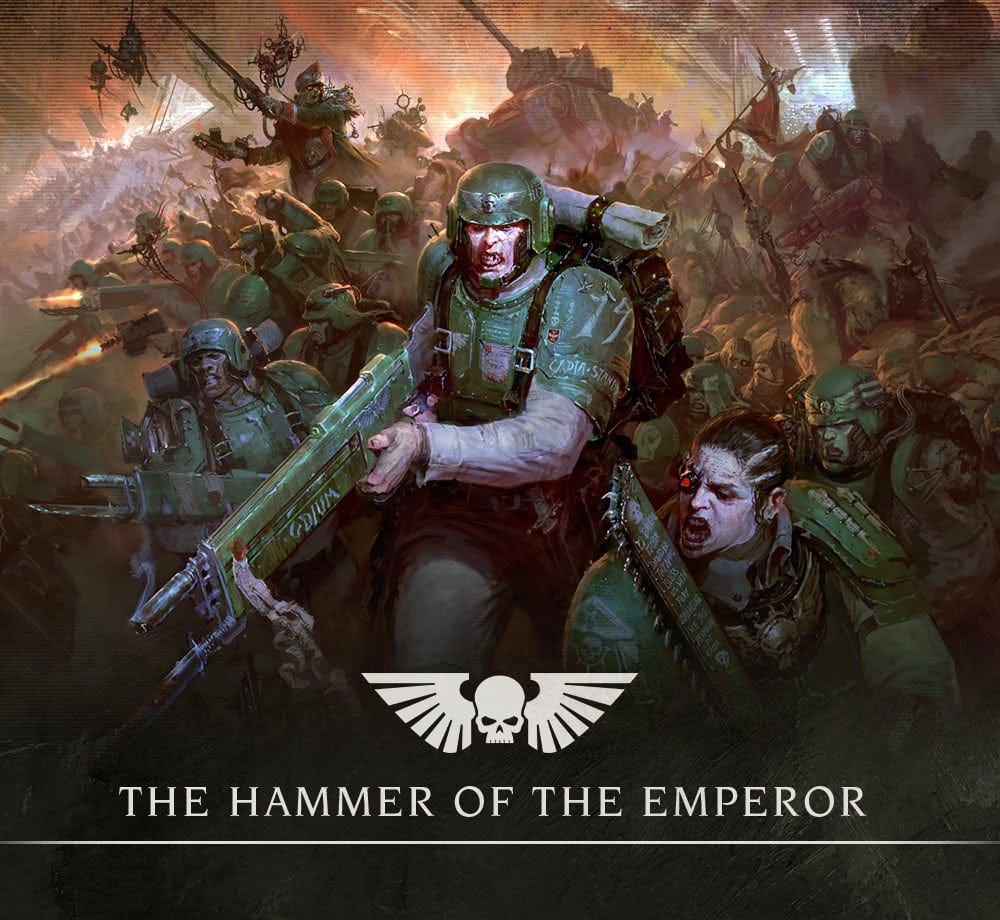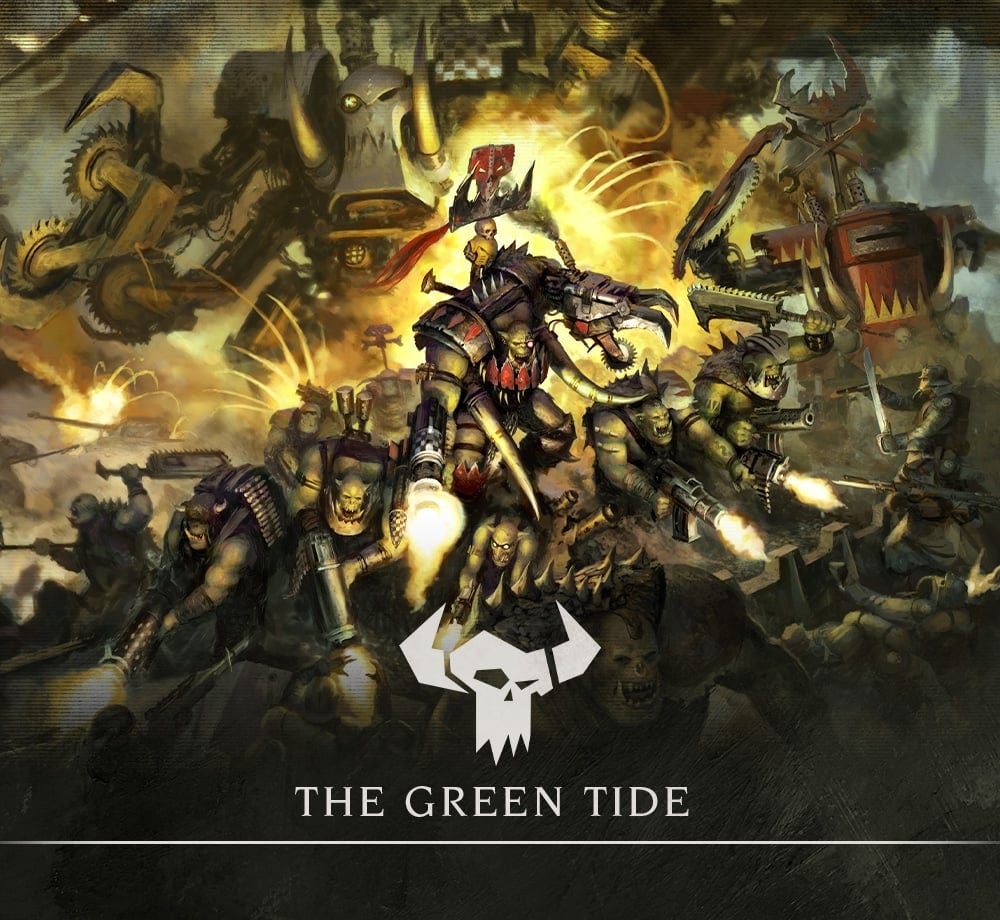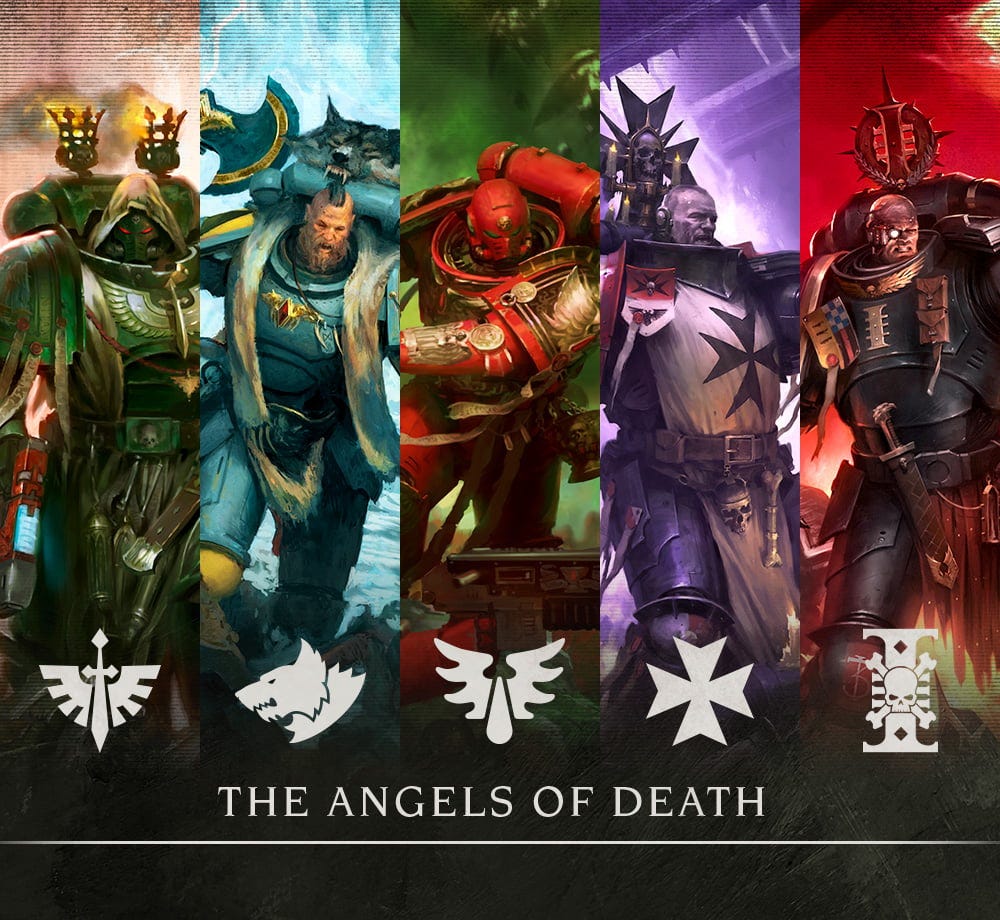Getting Into Warhammer 40K – The Factions
More gits than you can krump with a beaky’s snazzhammer.
PART I | PART II | PART III | PART IV | PART V
The universe of Warhammer 40K is vast, borrowing from every sci-fi genre and franchise you can think of over thirty-five years of novels, rulebooks, and other media. Covering it all in a single article is impossible. But for anybody trying to get into the tabletop game, the first things to understand are the available factions.
Factions in Warhammer 40K fall into three categories: Imperial, Chaos, and Xenos. Each category covers at least a dozen factions and sub-factions, each with their own dynamics, allies, and enemies.
The Imperium
Firstly, the Imperium of Man. Taking inspiration from the pro-fascist overtones of Starship Troopers (the DNA of which serves as the foundation for the entire 40K setting), and possibly responding to the politics of the day (Warhammer 40K was released in 1987, during the height of Margaret Thatcher’s Prime Minister-ship. Fans often describe Warhammer 40K as a political satire, though Games Workshop refuses to acknowledge this), mankind in the 41st millennium is depicted as a galaxies-spanning fascist empire that worships the “God-Emperor of Mankind,” a larger-than-life super-man who may or may not be dead and may or may not be a god.
They are the “good guys” of the setting.
The Imperium, being the most relatable faction (by virtue of containing humans and not, I think, fascist space-nuns), has the most sub-factions.
Take the Space Marines (or “Adeptus Astartes,” if you prefer. Latin names go hard in 40K). You may recognize the super-soldiers in blue armor from nearly all of the advertising. The blue ones are called “Ultramarines,” and they are only one of dozens of Space Marine chapters. Some Space Marine chapters are popular enough to warrant their own rulebooks, but there are countless others that do not.
What this means in real life terms is that there is one VERY large line of Space Marine miniatures that you are encouraged to paint however you want: adhering to a pre-existing color scheme or making up your own chapter with its own colors.
Other Imperium factions include the Adepta Sororitas or Sisters of Battle, a group of all-female monastic warriors best described as “nuns with guns”; the Adeptus Mechanicus, a technology-worshipping cult that believes that machines have souls; the Imperial Knights, for those who like giant robots and Arthurian Romances; the Astra Militarum or Imperial Guard, who are your boots-on-the-ground military force; and the Adeptus Custodes, who are like Space Marines but bigger. They protect the God Emperor on his throne on Terra (the setting’s name for Earth).
Chaos
Next are the forces of Chaos. These are the bad guys of the setting. Considering that the good guys are xenophobic fascist zealots, the only way anybody could be MORE evil is if they were a literal demon, so Chaos employs literal demons.
Most Chaos factions are just “corrupt” versions of Imperium factions, including “CHAOS Space Marines” and “CHAOS Knights,” as well as the literal demons. Chaos factions tend to be more interesting than their uncorrupted counterparts due to being half-demon monstrosities with powers far greater than your run-of-the-mill space fascist.
In lore, servants of Chaos are cultists, complete with horrible blood-rituals and demon summoning: all of the abhorrent things your grandmother thought Dungeons & Dragons was guilty of back in the 80s. (The fact that there was no “satanic panic” over a game where cultists who offer human sacrifices to dark gods are not just antagonists, but a PLAYABLE FACTION is, in retrospect, both hilarious and sad.)
Xenos (aka, the rest of them)
Last are the Xenos factions, which are not a unified force, but rather the category into which all other factions fall. Xenos are the alien races, each with their own history, culture, and sub-factions.
There are the Eldar, space-elves who are everything you’d expect elves to be: graceful, long-lived, and way too self-important. The Eldar are divided into four smaller factions: Craftworld Eldar (your typical “high” elf), Drukhari (dark elves), and Harlequins (psycho space-jesters). There’s also the Ynnari, a suicide cult made up of members of the previous three factions.
You may have noticed a theme. Many of Warhammer 40K’s Xenos factions are just fantasy races with a sci-fi re-skin. Which is why it should be no surprise that one of the biggest factions is Orks. Orks love to fight, overwhelm the galaxy with their numbers, and are generally unpleasant to be around. They are also the comic relief, being incredibly stupid, but also the only creatures in the setting that seem to be having a good time.
There are also the Necrons (Egyptian space-terminators), the Tau (Communist mecha pilots, and the only non-xenophobic faction in the game), Tyranids (ravenous alien bugs), and Genestealer Cults (human-Tyranid hybrids who infiltrate worlds and tear them apart from the inside, a la Invasion of the Body Snatchers).
So how many factions?
If we go by the number of available faction rulebooks, or codices, there are about twenty factions in the game. But that doesn’t include the TWELVE “supplemental” codices for specific brands of Space Marine; nor does it include the two 8th edition codices dedicated to factions from the spin-off game Kill Team; nor does it cover factions like the Sisters of Silence, who are too small to warrant their own codex and have therefore been shoved into the Custodes’ codex; or the Ynnari, which require three different rulebooks to cobble together and play. Oh, and then there are the factions that have joined bigger factions after a brief solo career, like the Skitarii and Cult Mechanicus.
Not only that, but factions like the Thousand Sons and Death Guard are just Chaos Space Marines popular enough to warrant their own rules, with the World Eaters just receiving a codex this year. Factions like the Emperor’s Children are still waiting for their time in the spotlight.
Also, during the drafting of this article, Games Workshop re-introduced a faction they retired twenty years ago: the Leagues of Votann (formally the Squats), our missing space-dwarves.
Let’s just say there are twenty factions and counting.
These factions, while interesting, are also the first barrier to playing the game, Warhammer 40K. You can start by picking a faction that appeals to you, but with so many choices, that can be difficult. In the next part of this series, I’ll cover all the things that make getting into the game of Warhammer 40K difficult, and why it might not be the best place to start for people interested in the franchise.










Another great essay.
Looking forward to the next chapter!